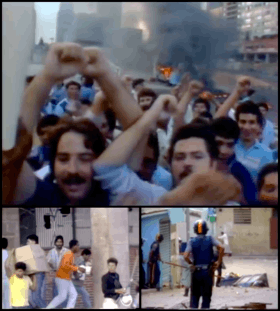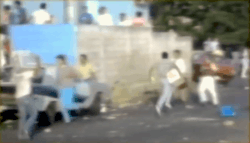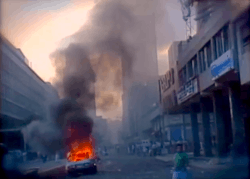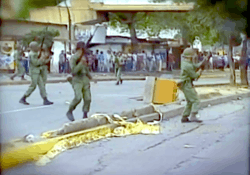Caracazo
| Caracazo | |||
|---|---|---|---|
 Top, left, right: Venezuelans cheering during the rioting. The looting of stores in Caracas. Police responding to a scene. | |||
| Date |
27 February 1989 – 8 March 1989 (9 days) | ||
| Location | Caracas | ||
| Caused by |
| ||
| Methods |
| ||
| Resulted in | |||
| Parties to the civil conflict | |||
|
| |||
| Casualties | |||
| Death(s) | 276–2000+[3][4] | ||
| Injuries | 2,000[5] | ||
The Caracazo, or sacudón, is the name given to the wave of protests, riots, looting, shootings and massacres[6] that began on 27 February 1989 in Venezuela's capital, Caracas, and the surrounding towns. The weeklong clashes resulted in the deaths of hundreds of people, thousands by some accounts, mostly at the hands of security forces and the military.[3][7][8] The riots and the protests began mainly in response to the government's economic reforms and the resulting increase in the price of gasoline and transportation.[6]
Etymology
The word Caracazo is the name of the city followed by the -azo suffix, which denotes a violent knock. Its translation could therefore be "the Caracas smash" or "the big one in Caracas". The name was inspired by the Bogotazo, a massive riot in neighboring Colombia in 1948, which played a pivotal role in that country's history. Sacudón is from sacudir (to shake) and means something along the lines of "the day that shook the country" (see Spanish nouns: Other suffixes).
The words are pronounced [kaɾaˈkaso] and [sakuˈðon], respectively.
Background
A fall in oil prices in the mid-1980s caused an economic crisis to take hold in Venezuela, and the country had accrued significant levels of debt. Nevertheless, the administration of the left-leaning President Jaime Lusinchi was able to restructure the country's debt repayments and offset an economic crisis but allow for the continuation of the government's policies of social spending and state-sponsored subsidies.[9]
Lusinchi's political party, the Democratic Action, was able to remain in power following the 1988 election of Carlos Andrés Pérez as president. Pérez then proposed a major shift in policy by implementing neoliberal economic reforms recommended by the International Monetary Fund (IMF). The program, called El Gran Viraje (The Great Turn), but popularly known as the paquete (the "package"), was contrary to statements made during Pérez's populist campaign in which he had described the IMF as "a neutron bomb that killed people, but left buildings standing."[10]
Measures taken by Pérez included privatizing state companies, tax reform, reducing customs duties, and diminishing the role of the state in the economy. He also took measures to decentralize and modernize the Venezuelan political system by the direct election of state governors, who had previously been appointed by the president. The most controversial part of the economic reform package was the elimination of the gasoline subsidies, which had long maintained domestic gasoline prices far beneath international levels and even the production costs. When the subsidy was eliminated, gasoline prices rose by as much as 100% and so the costs of public transportation rose by 30%.
Weeks before the outbreak of rioting, Carlos Andrés Pérez was inaugurated on 2 February 1989. During the "lavish ceremony", Fidel Castro and other Cuban personnel entered Venezuela for the event. With Cuba recently entering its Special Period, experiencing economic difficulties as a result of the Soviet Union's Perestroika, Castro allegedly sought to establish an ally in Venezuela so Cuba could also enjoy funds oil profits. The group of Cubans allegedly established a headquarters at the nearly finished Eurobuilding Hotel in Caracas and after the event, Venezuelan intelligence reported that less Cuban personnel departed from Venezuela than arrived. Cuban sleeper agents then allegedly waited for unrest to occur in Venezuela so they could exacerbate political tensions.[2]
Protests and rioting

The protests and rioting began on the morning of February 27, 1989, in Guarenas, a town in Miranda State about 30 kilometres (19 mi) east of Caracas, by the steep increase in public transportation prices.[3][11] The protests and rioting quickly spread to the capital and other towns across the country. A lack of timely intervention by authorities - some police were under orders not to take action - led to the Metropolitan Police quickly being overwhelmed.[3] Despite initial debate within the government over how to manage the situation, a heavyhanded approach was implemented, with a state of emergency and martial law being imposed.[3]
On February 28, Pérez suspended a number of articles of the Constitution, including Article 60 (right to individual liberty and security), Article 62 (inviolability of the home), Article 66 (freedom of expression), Article 71 (right to gather publicly and privately), and Article 115 (right to peaceful protest).[12] The rights were not completely restored until March 22, and in the interim, there was no official decree or resolution to define how government authority would be exercised in the absence of those constitutional rights.[12]


By the time authorities encountered the scenes of rioting, citizens began firing weapons at officers, with ensuing firefights resulted in many bystanders being killed by "bullets from army troops and from sniping protesters".[1][3] In many poor areas, citizens destroyed their own local commercial facilities, with food markets so damaged that their food distribution system was ruined.[1] Much of the rioters destroyed properties indiscriminately, with no motives related to initial protests.[1] According to Amnesty International, tactics used by security forces included "disappearances," the use of torture, and extrajudicial killings.[8] As part of the government's security forces, members of Hugo Chávez's MBR-200 allegedly participated in the crackdown.[13] Chávez himself was sick that day with the measles.[14] As tensions eased, troops began to sweep through neighborhoods collecting appliances and cash registers, telling citizens that if they provided a certificate of purchase, the items would be returned.[1]
The initial official pronouncements said 276 people had died[11] but many estimates put the number at above 2,000.[4] Shortages of coffins were reported and many Venezuelans had to line up at government food distribution centers since markets were destroyed by rioters.[1] Insurance estimates of damage caused during the rioting were $90 million CAD ($120 million 2017 USD).[1]
Aftermath and consequences
On March 3, 1989, Pérez spoke with U.S. President George H. W. Bush. President Bush offered President Pérez a US$450 million emergency loan. Pérez thanked Bush and asked him to support a change in debt policy toward Latin America: "I want to tell you if there is no change in [international] debt policy then whatever we may do here may be useless."[15] Pérez told Bush that he had sent him a letter several days earlier and that he would appreciate it if he would read it.[15]
Political instability
The clearest consequence of the Caracazo was political instability. The following February, the army was called to contain similar riots in Puerto La Cruz and Barcelona and again in June, when rising of transportation costs ended in riots in Maracaibo and other cities. The reforms were modified.
The MBR-200 repudiated the Caracazo and accelerated its preparation for a coup d'état against the Perez government.[16] In 1992 there were two attempted coups in February and November. Pérez was later accused of corruption and removed from the presidency. Chávez, a MBR-200 leader and an organiser of one of the coups, was found guilty of sedition and incarcerated. However, he was subsequently pardoned by Pérez's successor, Rafael Caldera, and he went on to be elected president after the latter. Chavez later explained that after the event, "the members of the MBR 200 realized we had passed the point of no return and we had to take up arms. We could not continue to defend a murderous regime."[16]
Investigations

In 1998, the Inter-American Commission on Human Rights condemned the government's action and referred the case to the Inter-American Court of Human Rights. In 1999, the Court heard the case and found that the government had committed violations of human rights, including extrajudicial killings. The Venezuelan government, by then headed by Chávez, did not contest the findings of the case and accepted full responsibility for the government's actions.[11]
In August 2009, Defense Minister Italo del Valle Alliegro was charged in relation to the Caracazo.[17] In July 2010, the Supreme Court overturned an appeal court ruling, which had declared the case covered by a statute of limitations.[18]
See also
Further reading
- Margarita López Maya, "The Venezuelan Caracazo of 1989: Popular Protest and Institutional Weakness", Journal of Latin American Studies, Vol.35, No.1 (2003) pp. 117–37.
- "The President's Telephone Conversation with President Carlos Andres Perez of Venezuela on March 3, 1989." George H.W. Bush Presidential Library Archives, Memcons and Telecons. Accessed October 26, 2011.
References
- 1 2 3 4 5 6 7 "Riots leave Venezuela short of coffins; Up to 700 reported dead while hospitals say most of the injured were shot: B1". The Gazette. 5 March 1989.
- 1 2 Peñaloza, General Carlos (2014). El Delfín de Fidel: La historia oculta tras el golpe del 4F. p. 185. ISBN 1505750334.
On February 5, 1989, the transmission of Lusinchi's command to Pérez was effected with a lavish ceremony unprecedented in a democracy. Fidel ... was pressured by the "perestroika" that threatened the existence of the Cuban communist regime. The Soviet economic problems made it urgent to control Venezuela to enjoy its oil income ... Fidel stole the show with his Bolivarian allusions of the Latin American Union and a call to fight against Yankee imperialism ... the Cubans and their materials arrived at Caracas on a bus and the buses and trucks to the Eurobuilding hotel ... they were delivered three days before the arrival of Fidel to Cuban G2 officers who paid their rent in advance and made strange demands. ... After the "coronation", part of the Cuban contingent left the country ... sources reported from Maiquetía that fewer Cubans had left than those who had entered
- 1 2 3 4 5 6 Uppsala Conflict Data Program Conflict Encyclopedia, Venezuela, One-sided Violence, Government of Venezuela - civilians, http://www.ucdp.uu.se/gpdatabase/gpcountry.php?id=167®ionSelect=5-Southern_Americas#
- 1 2 Crisp, Brian F. (1998), "Presidential Decree Authority in Venezuela", in John M. Carey and Matthew Soberg Shugart (eds, 1998), Executive decree authority, Cambridge University Press. p157
- ↑ UN, VENEZUELA: Wound Still Gaping 20 Years after ‘Caracazo’, By Humberto Márquez, CARACAS, Feb 27 2009 (IPS, http://www.ipsnews.net/2009/02/venezuela-wound-still-gaping-20-years-after-lsquocaracazorsquo/
- 1 2 Venezuela exhumes unnamed dead in riot investigation, Reuters, 22 September 2009 .
- ↑ UN, VENEZUELA: Wound Still Gaping 20 Years after ‘Caracazo’, By Humberto Márquez, CARACAS, Feb 27 2009 (IPS),http://www.ipsnews.net/2009/02/venezuela-wound-still-gaping-20-years-after-lsquocaracazorsquo/
- 1 2 Amnesty International, March 1990, Reports of Arbitrary Killings and Torture:, February/March 1989 , AI Index: AMR 53/02/90, https://www.amnesty.org/en/library/asset/AMR53/002/1991/en/4e4929fa-ee43-11dd-99b6-630c5239b672/amr530021991en.pdf
- ↑ Barcelona Centre for International Affairs, Jaime Lusinchi, (Spanish) http://www.cidob.org/es/documentacion/biografias_lideres_politicos/america_del_sur/venezuela/jaime_lusinchi#2
- ↑ Carlos Andrés Pérez, Obituary, Time Magazine, Jan. 10 2011
- 1 2 3 El Caracazo Case, Judgment of 11 November 1999, Inter-American Court of Human Rights, accessed 1 May 2007
- 1 2 Crisp, Brian F. (1998), "Presidential Decree Authority in Venezuela", in John M. Carey and Matthew Soberg Shugart (eds, 1998), Executive decree authority, Cambridge University Press. p150
- ↑ Nelson, Brian A. (2009). The silence and the scorpion: the coup against Chávez and the making of modern Venezuela (online ed.). New York: Nation Books. p. 24. ISBN 1568584180.
- ↑ Kozloff, Nikolas (2007). Hugo Chávez: Oil, Politics, and the Challenge to the U.S. Palgrave Macmillan. p. 45. ISBN 9781403984098.
- 1 2 Bush Presidential Library, 3 March 1989, Memcons and Telcons, http://bushlibrary.tamu.edu/research/pdfs/memcons_telcons/1989-03-03--Perez.pdf
- 1 2 Hellinger, Daniel (2014). Comparative Politics of Latin America: Democracy at Last?. Routledge. ISBN 9781134070077.
- ↑ BBC, 18 July 2009, Former Venezuela minister charged
- ↑ Latin American Herald Tribune, 2 August 2010, Venezuela’s Ex-Defense Chief May Face Charges for ‘89 Repression